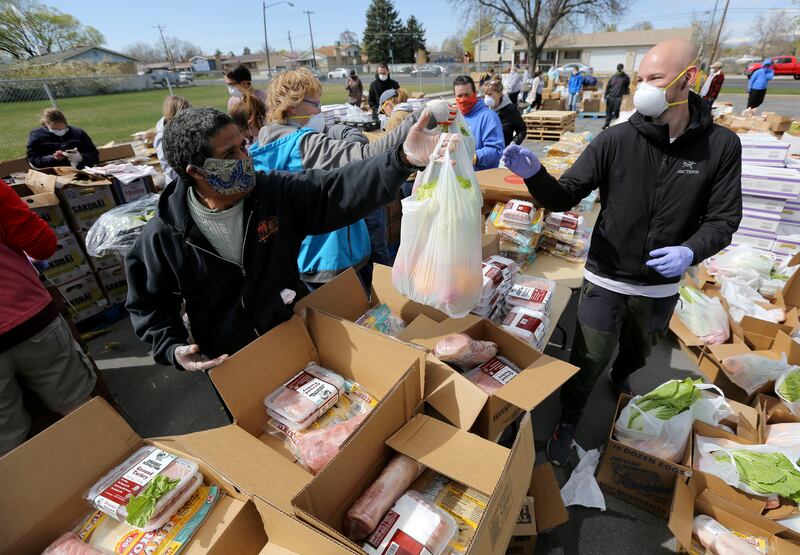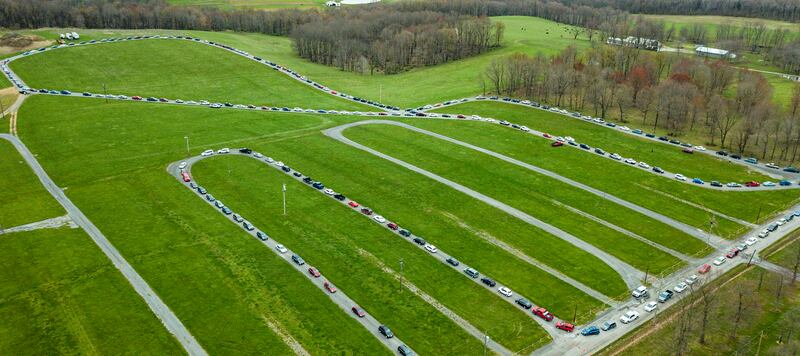SALT LAKE CITY — Thousands of cars lined up outside a single food bank in San Antonio, Texas. In Las Vegas, people slept on the ground of a parking lot, separated by lines of white paint. Masked faces tentatively boarded Detroit buses, fearful of shared air and crammed seats.
These are just a few of the images that have emerged as the global pandemic has spread across the United States. Although members of all economic classes have suffered from COVID-19, lower-income individuals are getting hit harder on all fronts — from rates of infection to devastating job loss.

By late April, Pew Research Center found that nearly half of lower-income Americans — families making less than $37,500 a year, had lost their jobs or wages because of the coronavirus. Pew also found that only 23% had emergency funds set aside to cover living expenses for three months.
Sectors that have experienced the greatest job loss, like hotels and restaurants, are also those with the lowest wages. In Utah, waiters and waitresses make about $9.90 an hour and hotel clerks make about $11.23 an hour.
“With very high rents and low wages, people were already kind of struggling to get by. And now that income has been pulled out from underneath them,” Glenn Bailey, the executive director of Crossroads Urban Center, a nonprofit that provides assistance to low-income Utahns, said.
Bailey said that despite having to close one of their two food pantries and limiting the pantry’s hours to just five a day in order to maintain the best sanitary practices, they are “serving more people more often.”
“We’re also serving families, but some of the families coming to us either haven’t had to come in a long time or have never been here before,” Bailey said.
Workers in the hardest hit industries are more likely to be living paycheck to paycheck, to not have an emergency fund, and they’re more likely to be renters, according to Juliette Tennert, director of economic and public policy research at the Kem C. Gardner Policy Institute.
“I’ve heard some pundits say that COVID-19 has been a great equalizer because everyone is touched in the same way. But it’s not the great equalizer. It’s those more vulnerable participants in the economy that are more unequally impacted,” Tennert said.
Those who have kept their jobs face other dangers. Lower wage earners who have kept their jobs tend to be in sectors that put them at greater risk of exposure to the coronavirus— from grocery store clerks to truck drivers to warehouse workers. By mid-April, 41 grocery store workers died due to COVID-19 according to The Washington Post.
In New York, the nation’s epicenter of the epidemic, working class neighborhoods in Queens contracted the greatest number of cases.
The virus is also disproportionately spreading in communities of color.
The Washington Post analyzed census demographics and found “counties that are majority-black have three times the rate of infections and almost six times the rate of deaths as counties where white residents are in the majority.”
The virus hits those with preexisting health conditions particularly hard. “And we know that African Americans are living with those underlying conditions every day, probably in larger proportions than most of our fellow Americans,” D.C. Mayor Muriel E. Bowser told MSNBC.
In an article published in The Conversation, Grace Noppert, an epidemiologist at University of North Carolina at Chapel Hill, wrote COVID-19 can “thrive among populations that are living in low-income communities both because of increased exposure to infectious pathogens and a reduced ability of individuals to fight infections.”
She explained that’s partially because “one of the most insidious effects of living in a low-income community is the chronic toll of stress on the body, particularly the immune system. Socioeconomic disadvantage, via discrimination, job and housing instability and food insecurity, result in increased stress.”
Housing insecurity and food instability have only become greater threats as families worry about missing rent, possibly facing eviction, and food banks struggle to keep up with a surge in demand.
On top of that, many lower income families don’t have health insurance, can’t afford the financial toll of receiving treatment for COVID-19, or access to the preventative care that might have helped create better outcomes in the first place. Reports indicate 27.5 million Americans were uninsured in 2018.
Beth Armstrong, the executive director of the People’s Health Clinic, a nonprofit clinic that provides free health services to the uninsured in Summit and Wasatch counties, said they’ve seen a surge in the number of people seeking their services.
“People who’ve been uninsured for years, but were never sick are now either getting sick or are worried about getting sick,” Armstrong said.
Armstrong explained that many of their patients don’t have the luxury of practicing social distancing. “Even if one person did get sick, they can’t go to another room and quarantine themselves. There’s just nowhere to go.”
The clinic has also been making a push to do more telemedicine, but even access to the internet can be a barrier.
When patients do have to come in, they don’t always have a viable option for childcare, making efforts to limit the number of individuals in a room during an appointment impossible sometimes.
Staying inside and limiting exposure to those in a crowded household are less feasible with fewer resources and space.
“I find that to be one of the most sort of insidious problems,” Armstrong said. “It just is difficult for our clients to protect their families once anyone in the family is tested positive.”
On the economic side, while there’s been a patchwork of responses from federal, state and local governments, it has taken weeks for aid to actually land in the hands of those who need it most.
Coordination is one of the biggest issues when it comes to serving low income people at this time, Bailey at Crossroads Urban Center explained. While grassroots efforts and mutual aid organizations have sprung up to help those in need, without a centralized organization distributing the information, people like Bailey struggle to advise those looking for help.
“Things are happening. It’s just a question of sort of publicizing and coordinating those things,” Bailey said.
Tennert, at the Kem C. Gardner Institute, said measures like the Economic Impact Payment (i.e., the stimulus check) are important, but it’s necessary to get those resources to people in need more quickly.
One of the worst policy moves would be to put austerity measures in place, and start cutting federal and state programs — like unemployment benefits or the Supplemental Nutrition Assistance Program, that people are especially reliant on now, Tennert said.
“Things are not going to snap back in two months. It’s going to take time to stabilize.”
Others hope the virus may be an opening for greater changes, from reforming the health care system to reconsidering the minimum wage.
“This inequality existed. But we’re seeing a light being shined on it in a new way,” Tennert said.


